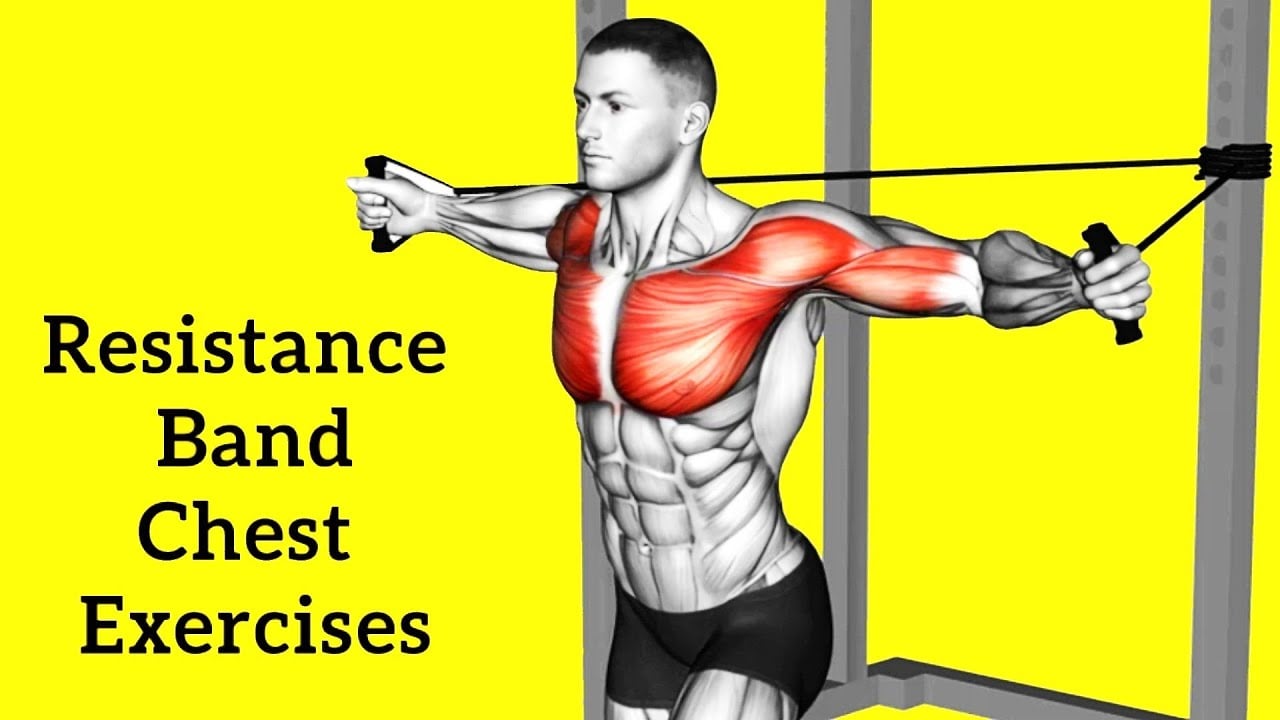Are you looking for a way to build a strong and sculpted chest at home? If so, resistance band chest exercises are a great option for you.
Why band chest exercises are so crucial? Resistance bands are an affordable and versatile way to work, and they are used to target all the major muscle groups in your chest.
Resistance bands are lightweight, portable, and provide tension to work your chest through its full range of motion. With just a resistance band, you can perform push-ups, flyes, presses, and more to build upper body strength.
In this post, we’ll explain the benefits of resistance band chest workouts and proper form and provide a complete list of the best exercises to add to your chest workout routine.
Use Our Free Calculator To Know Your Calories Requirement To Gain Muscle Mass

- What Is Resistance Chest Workout
- How Resistance Band Train Chest
- 10 Best Band Chest Exercises At Home
- 1. Standing Band Chest Press
- 2. Standing Incline Band Press
- 3. Standing Decline Band Press
- 4. Resistance Band Chest Fly
- 5. Low To High Band Fly
- 6. High To Low Band Fly
- 7. Resistance Band Push-Up
- 8. Band Pullovers
- 9. Band Floor Press
- 10. Resistance Band Punches
- Resistance Band Chest Workout Routines
- 1. Select Training Plan As Per Your Goal
- 2. Do Both Compound and Isolation Movement
- 3. Band Chest Workout Routine For Beginner
- 4. Band Workout Routine For Intermediate
- Benefits Of Doing Chest Workout With Resistance Band
- FAQs
- Can resistance bands build chests?
- Are resistance bands better than weights?
- Resistance Band Lower Chest Exercises
- How Do You Build Your Upper Chest with Bands?
- Inner Chest Workout With Band
- References
What Is Resistance Chest Workout
You can use various gym equipment or your own bodyweight as a resistance. Barbells, dumbbells, resistance bands, and weight machines are all common resistance tools used for chest workouts.
Resistance band chest workout is a form of resistance training that uses bands to target the chest muscles (the pectoralis major and pectoralis minor). It puts these muscles under tension and makes them work harder than usual.
This overuses the chest muscles, causing microtears and muscle damage. Then, the body repairs and grows the chest muscles.
In contrast to free weights, where gravity affects tension, resistance bands provide continuous tension as you stretch them. This means that the resistance increases the further you stretch the band.
The exercise is more challenging at the point of peak contraction. The constant tension placed on the chest muscles promotes muscle activation and growth. They also give you an excellent range of motion.
How Resistance Band Train Chest
Resistance bands provide unique tension during both concentric and eccentric phases. This means that you feel resistance when you contract the muscle (concentric phase) and lengthen the muscle (eccentric phase).
- The concentric phase is the shortening of the chest muscle, such as when you lift a weight.
- The eccentric phase is the muscle chest lengthening, such as lowering the weight.
Imagine stretching a rubber band. It resists and wants to return to its original size. Well, resistance bands work similarly. When you stretch them, they push against you.
When you allow the bands to return slowly and in control, they will attempt to pull you back, making your chest muscles work even harder.
Remember to be in charge and let them return to their starting position.
10 Best Band Chest Exercises At Home
Here are the Best band chest exercises that help build bigger and wider Chests. These exercises will hit your pecs from all angles.
1. Standing Band Chest Press
The banded chest press is a popular resistance band exercise that primarily targets the muscles of the chest. It is a multijoint exercise, which means that it works for multiple muscle groups at the same time, such as the shoulders and triceps.
Bands offer increased resistance as they are stretched, providing more excellent resistance at the peak of the movement.
Try Other Variations of Standing Band Press
- Single-Arm Band Press
- Alternating Standing Band Press
- Wide-Stance Standing Band Press
- Kneeling Band Press
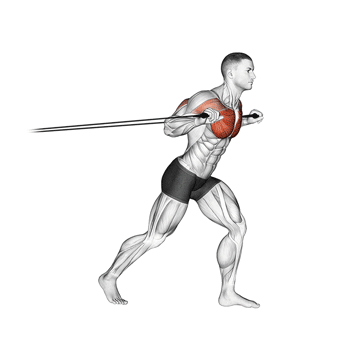
How To Do
- Anchor band at chest height. The band should be at chest level.
- Stand with your feet shoulder-width apart and hold the resistance band in each hand.
- Maintain an upright posture, engage your core, and keep your elbows tucked
- Breathe out and press both hands forward until your arms are straight. Use a full range of motion on each rep.
- Pause, then slowly return to the starting position.
- Repeat for 8–12 reps
- Perform slow, controlled motions focusing on muscle squeeze.
2. Standing Incline Band Press
The Inclined banded chest press, also known as the low-to-high chest Press, is a variation of the standard chest press that works the upper chest muscles.
To do that, you must anchor the resistance band to a lower position and press up.
Compared to heavy weights, resistance bands are gentler on the joints. This makes the incline band press suitable for people with joint sensitivity.
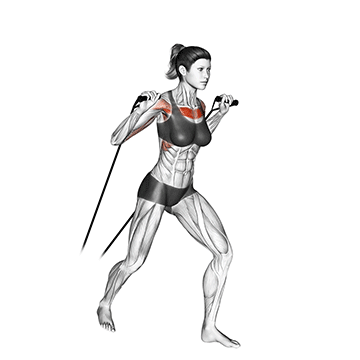
How To Do
- Use a resistance band that is challenging but not too difficult.
- Stand upright and anchor the resistance band below chest level to a secure object. You can adjust the anchor point to change the angle.
- Grab the resistance band handle with both hands.
- Exhale and press both hands upward. Straighten your arms completely, but keep your elbow slightly bent.
- Squeeze your chest muscles at the top of the movement. Hold for 1 second.
- Inhale and slowly return to the starting position.
- Repeat for 10–12 reps.
Know More: 15 Best Upper Chest Exercises For Mass And Strength
3. Standing Decline Band Press
The standing decline press (the high-to-low chest Press) trains the lower chest because you are doing the downward pressing motion.
Adjust the anchor point of the resistance band to a high position and do the downward pressing. Targeting the lower chest muscle groups helps build a more well-rounded chest.
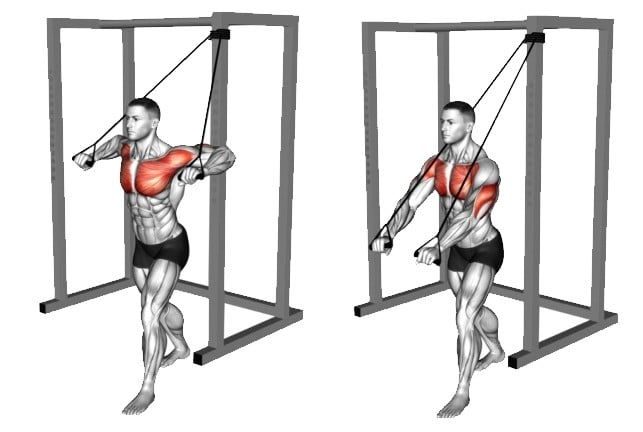
How To Do
- Stand upright and attach the resistance band to a secure object above chest level. You can adjust the anchor point to change the angle.
- Grab the resistance band handle with both hands.
- Exhale and press both hands upward. Straighten your arms completely, but keep your elbow slightly bent.
- Squeeze your chest muscles at the top of the movement. Hold for 1 second.
- Inhale and slowly return to the starting position.
- Repeat for 10–12 reps.
4. Resistance Band Chest Fly
If you’re looking for straightforward band chest exercises to add to your routine, band flys are a great staple exercise to get you started.
The band fly is a great band exercise that helps isolate the chest muscles. It also helps develop and define the chest muscles, specifically the Inner pectoral muscles.
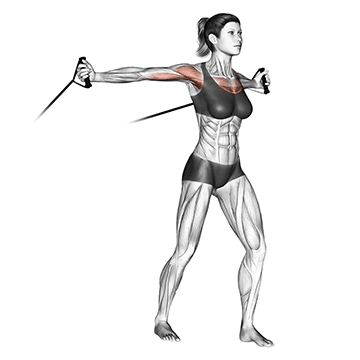
How To Do
- Attach the resistance band to a sturdy anchor at chest height.
- Stand with your back to the anchor and hold a handle in each hand.
- Start with your arms extended out to the sides at shoulder height.
- Bring your arms forward in a hugging motion with a slight bend in your elbows.
- Squeeze your chest at the end of the movement.
- Slowly return to the starting position.
- Repeat for the desired number of repetitions.
5. Low To High Band Fly
The standing low to high band fly is a variation of the chest fly that strengthens the pushing muscles of the body, including the chest, triceps, and shoulders. It provides constant tension, helping build upper pecs.
Low to High band fly exercise helps to develop and define upper and inner pectoral muscles.
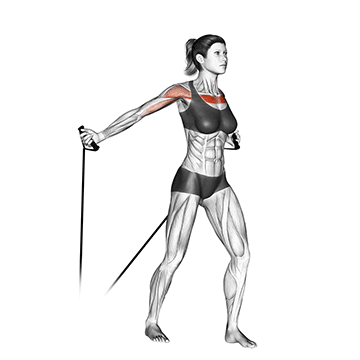
How To Do
- Attach the resistance band to a low anchor point, such as a doorknob
- In a standing position, hold the resistance band in each hand with your arms extended out to the sides
- Bend your elbows slightly and pull your hands toward each other in wide arcs in front of you, pausing when your hands touch.
- Slowly lower back to the starting position. Keep tension on the band at all times.
- Repeat for the desired number of repetitions.
6. High To Low Band Fly
The high-to-low band fly is a variation of the band chest fly, and it is a great exercise for targeting the lower portion of your chest. It primarily targets the chest but also, to a lesser degree, the shoulders and triceps.
In this movement, you’re pulling the resistance bands from high to low positions in a hugging motion.
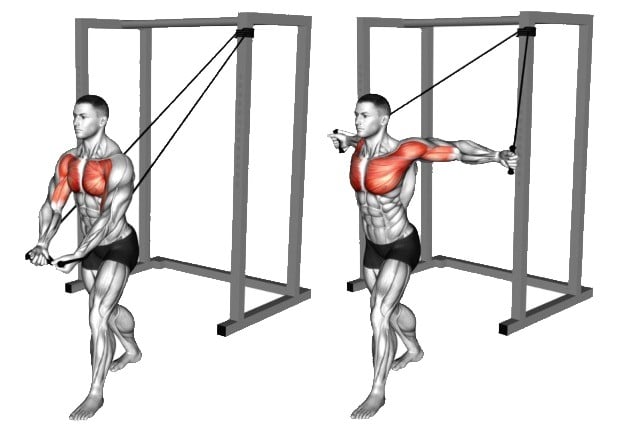
How To Do
- Attach the resistance band to a high anchor point.
- Stand with your feet shoulder-width apart. Hold the band in each hand with your arms out to the sides.
- Maintain a straight back, relaxed shoulders, and an engaged core.
- Bend your elbows slightly and pull your hands (high to low) toward each other in wide arcs in front of you.
- Slowly return to the starting position. Inhale as you open your arms and exhale as you bring them together.
- Complete 10–12 reps
Read More: Lower Chest Cable Exercises For Bigger & Stronger Chest
7. Resistance Band Push-Up
Push-ups can be performed, regardless of where you are and, best of all, they are completely free—no expensive equipment or annual gym fees required.
The classic push-up has survived the test of time and is the single most efficient exercise to simultaneously strengthen the chest, arms, deltoid, lower back, abs and glutes.
The resistance bands add variable resistance, which makes the push-up movement more challenging. One study found that strength improvements were similar when doing 6 rep max bench press and 6 rep max elastic band pushups.
These different types of push-ups often involve altering hand and foot positions, impacting muscle recruitment patterns.
A number of potential hand positions exist; the most common classifications include:
- Wide base (150% shoulder width) Known as Band Wide Grip Push Up
- Normal base (shoulder width), aka Band Standard Push Up
- Narrow base (50% shoulder width) aka Band Close Grip Push Up
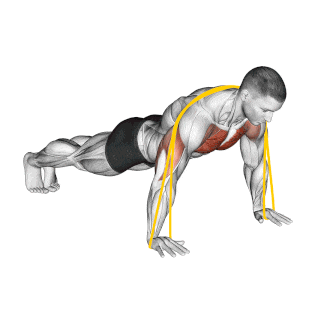
How To Do
- Place the resistance band across your upper back and hold on to the band’s ends, one in each hand.
- Start in a high plank position with your hands slightly wider than shoulder-width apart.
- Keep your body straight from your head to your heels. Don’t let your hips sag or your back arch.
- Engage your core, squeeze your glutes, and maintain a neutral spine.
- Bend your elbows and lower your body towards the ground. Keep your elbows close to your sides.
- Pause for a moment at the bottom position.
- Then, push through your palms. As you push back up, the resistance from the bands intensifies the upward movement.
- Inhale as you lower your body, and exhale as you push back up.
Know More: 25 Different Types Of Push Ups (Best Variations)
8. Band Pullovers
The lying band pullover is an excellent alternative to the barbell or dumbbell pullover. It is the best band exercise for building a strong rib cage and serratus anterior muscle, which is necessary for a complete chest and back.
Band pullovers are an effective compound exercise that engages the chest muscles and the lats (latissimus dorsi), building upper body mass and strength.
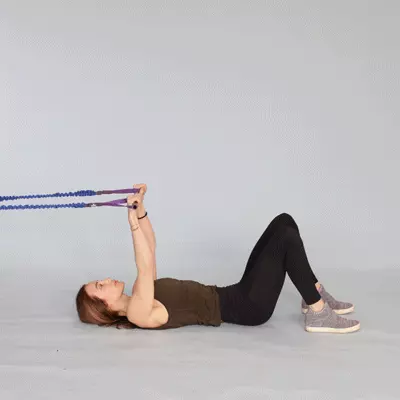
How To Do
- Anchor the resistance band securely at a low point. Lie down on a bench or on the floor.
- Hold the band’s handles above your chest with your arms fully extended.
- Keep a slight bend in your elbows and lower your arms backward in an arc-like motion.
- Pause, and then slowly pull the handles back up to the starting position. Repeat for desired reps.
- Do the exercise slowly, and do not use momentum.
9. Band Floor Press
The band floor press is a resistance band exercise that is a variation of the traditional one. In this particular movement, resistance bands give tension and resistance while the movement is performed while lying on the floor.
The band floor press is considered joint-friendly, as it reduces stress on the shoulders and lower back.
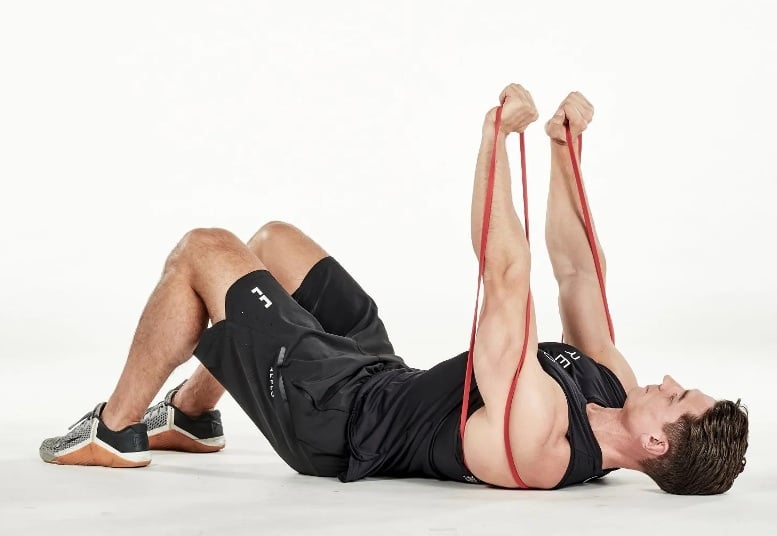
How To Do
- Lie on the floor, place the band under the midback, and grasp the handles.
- Raise arms straight up with elbows bent 90 degrees
- Engage chest muscles to press the band up until arms are extended
- Slowly return to the start position with control
- Repeat for 10–15 reps. Use a full range of motion on each rep.
10. Resistance Band Punches
Resistance band punches are dynamic exercises that combine resistance bands with punching movements. They target the shoulders, chest, and arms, primarily in the upper body.
It’s an excellent way to build upper body strength and endurance while adding cardio elements.
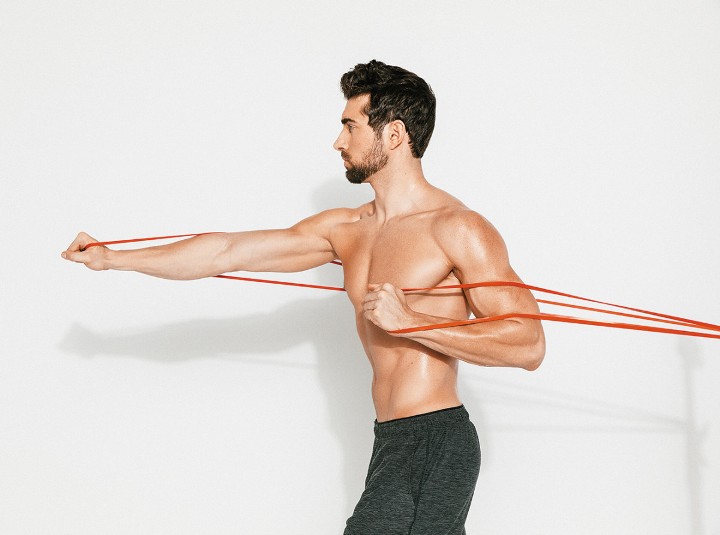
How To Do
- Attach the resistance band to a sturdy anchor at chest height.
- Place your feet shoulder-width apart and slightly bend your knees.
- Begin with your arms bent at a 90-degree angle and hands close to your chest.
- Extend one arm forward in a punching motion. As you punch, the resistance band provides tension that opposes your movement.
- Don’t swing your punches. Instead, focus on using your punching muscles to generate power.
- Continue alternating your arms in a punching motion, maintaining a controlled and rhythmic pace.
- Breathe rhythmically as you punch—inhale when pulling back and exhale when punching forward.
- Go for time or number of punches
Resistance Band Chest Workout Routines
To design an effective chest workout, add 2-3 band exercises that target all the chest muscles. Adjust the workout plan according to your fitness levels and goals.
It will be important to perform each set to muscular fatigue. In other words, the last few repetitions should be difficult, but you should be able to maintain ideal form, posture, and technique throughout the entire set.
1. Select Training Plan As Per Your Goal
- For muscle endurance: Aim for 3-4 sets of 12-15 reps, with moderate resistance.
- For muscle hypertrophy (increased muscle size): Aim for 3-4 sets of 8-12 reps, with a moderate to heavy resistance.
It is always best to start with fewer reps and sets and gradually increase them as your strength improves.
2. Do Both Compound and Isolation Movement
Several types of chest exercises can be performed using a resistance band.
Each exercise can be adjusted to meet your requirements and provides constant tension on the chest muscles throughout the entire range of motion.
- Band Chest Press: They are multijoint exercises that primarily focus on the chest muscle but also train the deltoid and the tricep.
- Band Flyes: Isolation chest exercises that train the pecs from a different angle. This exercise can be performed with both arms simultaneously or one arm at a time to further isolate the chest muscles.
- Push Ups: The bands intensify the resistance as you push up and put more emphasis on your chest muscles.
- Pullovers: This smooth motion effectively engages your chest and back muscles.
3. Band Chest Workout Routine For Beginner
| Exercise | Sets | Reps | Rest |
|---|---|---|---|
| Standing Band Chest Press | 3-4 | 8-10 | 60-90 seconds |
| Band Incline Bench Press | 3-4 | 8 | 60-90 seconds |
| Band Fly | 4 | 8-10 | 60-90 seconds |
4. Band Workout Routine For Intermediate
| Exercise | Sets | Reps | Rest |
|---|---|---|---|
| Single Arm Band Press | 4 | 8-10 | 45-60 seconds |
| Low To High Band Fly | 3-4 | 10-12 | 45-60 seconds |
| Band Pullover | 4 | 8-10 | 45-60 seconds |
| Band Push Ups | 3 | 10-12 | 45-60 seconds |
Benefits Of Doing Chest Workout With Resistance Band
There are many benefits to doing chest workouts with resistance bands. Here are a few of them:
- Resistance bands are lightweight and portable, so they can be taken anywhere. This makes them a great option for people who want to work out at home or on the go.
- Resistance bands are easy to use, even for beginners. They can be used to perform various exercises, and they can be adjusted to provide different levels of resistance.
- They are a low-impact and joint-friendly option, which means they put less stress on your joints than weights. This makes them a good choice for people with joint pain or injuries.
- Bands are relatively inexpensive, your budget-friendly option to get in shape.
- They provide continuous tension on your chest muscles throughout the entire range of motion, increasing muscle engagement and growth.
- Band workouts are quick and effective and work the upper body faster than traditional methods.
- Bands can target various muscle groups, including the chest, back, shoulders, and arms. This makes them a versatile option for people who would like to get a full-body workout.

FAQs
Can resistance bands build chests?
Yes, resistance bands are an effective tool for building chest muscle when appropriately used. The key to stimulating muscle growth is to progressive overload through challenging resistance, controlled motions, and focused technique.
Bands allow training the chest through a full range of motion while adjusting resistance as needed. By using resistance bands as your main resistance, you can grow the pectoral muscles over time.
Are resistance bands better than weights?
Resistance bands and weights both have unique benefits. Bands provide constant tension through the full range of motion and are extremely portable. Weights allow for easier progressive overload and muscle loading in specific movements.
For building chest, bands enable effective hypertrophy training, though weights may be better for maximal strength gains.
Ultimately, a training program combining resistance bands and weights provides complementing benefits for optimal muscle growth and strength development.
Resistance Band Lower Chest Exercises
Here is the list of the best lower chest band exercises, which help train the lower chest and build a well-developed chest.
- High to Low Band Fly
- Standing Decline Band Press
- Decline Press With Band
- Decline Band Fly
- Band-Assisted Chest Dip
- Incline Band Push-Ups
- Cable Pullovers
How Do You Build Your Upper Chest with Bands?
Here is a list of the best upper chest band exercises that help to build a well-developed chest.
- Standing Incline Band Press
- Low To High Band Fly
- Lying Incline Band Press
- Decline Band Push-Up
- Incline Band Pullovers
- Incline Band Fly
- Incline squeeze press With Band
Inner Chest Workout With Band
Here is a list of the best inner chest band exercises for building a well-developed chest.
- Band Squeeze press
- Band hug
- Middle Band fly
- Single-arm crossover
- Band Forward punch
- Band chest press
- Band Close Grip push-up
References
- Lopes JSS, et al. (2019). Effects of training with elastic resistance versus conventional resistance on muscular strength: A systematic review and meta-analysis.https://www.ncbi.nlm.nih.gov/pmc/articles/PMC6383082/
- Aboodarda SJ, Hamid MSA, Muhamed AMC, Ibrahim F, Thompson M. Resultant muscle torque and electromyographic activity during high intensity elastic resistance and free weight exercises. Eur J Sport Sci 13: 155–163, 2013.
- Calatayud, J., Borreani, S., Colado, J. C., Martin, F., Tella, V., & Andersen, L. L. (2015). Bench press and push-up at comparable levels of muscle activity results in similar strength gains. Journal of Strength and Conditioning Research, 29(1), 246-253. doi:10.1519/JSC.0000000000000589

Manish is a NASM-certified fitness and nutrition coach with over 10 years of experience in weight lifting and fat loss fitness coaching. He specializes in gym-based training and has a lot of knowledge about exercise, lifting technique, biomechanics, and more.
Through “Fit Life Regime,” he generously shares the insights he’s gained over a decade in the field. His goal is to equip others with the knowledge to start their own fitness journey.

